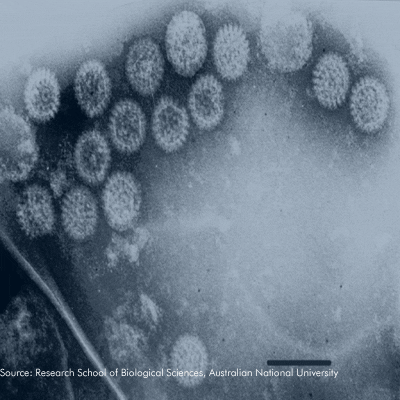| Virus | Bovine Rotavirus |
| Structure | Non-enveloped |
| Genome | Double stranded RNA |
| Family | Reoviridae |
| Primary Host | Cattle |
| Disease(s) Caused | Gastroenteritis (calf scour) |
| Symptoms | Diarrhea, reluctance to eat or drink |
| Potential Complications | Severe dehydration |
| Transmission Mode | Fecal-oral, contact with contaminated fomites |
| Sites of Community Outbreaks | Farms, ranches |
Importance of Bovine Rotavirus
Bovine rotavirus is a non-enveloped member of the Reoviridae family. It is responsible for most cases of neonatal diarrhea in calves, also known as calf scour.
Symptoms of rotavirus in calves include watery diarrhea and reluctance to eat or drink. In severe cases, this can lead to severe dehydration and electrolyte imbalance, sometimes resulting in death. These symptoms generally persist for 2-4 days, with viral shedding continuing for 5-7 days.
Bovine rotavirus can have significant economic consequences for farmers. The monetary value for the loss of calves has been found to be anywhere between $3 million and $8 million per year. Even if no calves die, they may take longer to reach their full weight.
Importance of Disinfection
As with other rotaviruses, bovine rotavirus is resistant to inactivation by temperature and humidity. Rotaviruses are resistant to several disinfectants, but are susceptible to glutaraldehydes, some quaternary ammonium compounds, and chlorine compounds.
Rotaviruses are spread through the fecal-oral route. Therefore, it is crucial that calves be kept in a clean environment, especially for the first 2-3 weeks of life when they are most susceptible. If possible, the location where calving occurs should be rotated roughly every two weeks to prevent older calves from contaminating newborns. Calves that are suspected to be infected should be isolated until the diarrhea ends. Any tools used to treat the sick calf must be thoroughly disinfected prior to further use.
Vaccines do exist for bovine rotavirus, but they are typically administered to the mother prior to calving. This is done to help boost the concentration of antibodies found in the colostrum. A calf fed with an adequate amount (1-2 quarts) of antibody-rich colostrum within the first 6 hours after birth will be significantly less susceptible to becoming ill from rotavirus infection. This protection will gradually wane as the intestinal lining is replaced and as the number of antibodies in the colostrum decreases.
References
- House, James A. “Economic impact of rotavirus and other neonatal disease agents of animals.” Journal of the American Veterinary Medical Association173.5 Pt 2 (1978): 573-576.
- Hudson, Don and White, R. Gene, “G75-269 Calf Scours: Causes, Prevention and Treatment” (1975). Historical Materials from University of Nebraska-Lincoln Extension. Paper 195.
- Smith, David R. “Preventing Calf Scours with the Sandhills Calving System.”

